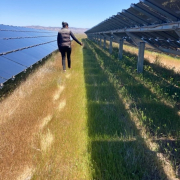Characterizing the Ecological Implications of Utility-Scale Solar Energy on Fallowed Farmlands
Written By: Amanda Gersoff (M.Sc. student), Dr. Seeta Sistla
Natural Resources Management and Environmental Sciences Department, Cal Poly, San Luis Obispo
Our team is studying the ecological aspects of utility-scale solar arrays set on former agricultural land whose understory is maintained by sheep grazing. By gaining a better understanding of the ecological implications associated with panel shading coupled with grazing by sheep, we hope to develop insights into agrivoltaic development that can maximize positive environmental effects while reducing negative externalities. We are currently focusing on two utility-scale solar energy sites located in San Luis Obispo County, California. At these sites, we conduct weekly monitoring to measure surface microclimatic features, soil nutrient cycling processes, and plant community composition.


We hypothesized that the novel shading caused by the arrays will affect plant and soil dynamics, including decomposition, biomass production, plant moisture content, the timing of plant community events (like flowering duration and time to senescence) and plant nutrient content. Our work has suggested that placing arrays in arid grazing landscapes that are emblematic of the western U.S. can confer synergistic benefits for the plant community and their grazers. For example, our work has found that the plant mass beneath the array rows has high water content, greater nitrogen content (correlated with higher soil plant-available nitrogen), and lower non-digestible fiber content than areas that are grazed but outside the arrays’ direct shading influence. We are currently tracking phenological patterns of greenness and flowering time/duration in the array, to better understand if the traits we are observing correlate with an extension of the growing season for the community with the array’s shading area.
Over the next year, we will continue monitoring to gain a more comprehensive understanding of how exactly spatial heterogeneity created by panel shading influences ecological systems. At both sites, the practice of solar grazing, in which sheep are used to maintain vegetation under solar panels, has been implemented. By combining agricultural and renewable energy production, also known as agrivoltaics, multiple benefits can be realized. Utilizing rotational grazing by sheep is beneficial because it can reduce the costs of mowing and maintenance, support local shepherds, cultivate biodiversity, cycle nutrients into the soil, and decrease the risk of sparks igniting dried grasses. As utility-scale solar energy grows, it is important to look to dual-use solar for increasing efficiency and maximizing environmental benefits.






